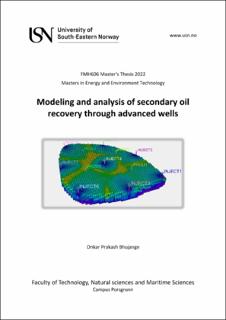| dc.description.abstract | Oil and gas will remain the most important source of energy for the foreseeable future and there is an urgent need to improve oil and gas recovery with less carbon footprint to meet the future energy demands. The extraction of oil from a reservoir starts by drilling a well into the oil zone. Initially, due to the high pressure, the oil is pushed towards the surface. But as the pressure inside the reservoir drops a mechanism such as water injection is required to maintain the pressure high inside the reservoir. The process is called secondary oil production. One of the main principles of achieving cost-effective and efficient oil recovery is maximizing the well-reservoir contact by using long horizontal wells. One of the main challenges of using such wells is early gas and/or water
breakthrough due to the heel-toe effect and heterogeneity along with the horizontal wells. To tackle this problem, advanced wells are used. Advanced wells are horizontal wells equipped with downhole Flow Control Devices (FCDs), which are passive Inflow Control
Devices (ICDs), Autonomous Inflow Control Devices (AICDs), Autonomous Inflow Control Valves (AICVs), and Interval Control Valves (ICVs). To achieve a successful design of horizontal wells, a suitable dynamic model of oil field and advanced wells must be developed. With and objective of comparing the vertical well production with horizontal good production and analyzing the effect of horizontal good length on the productivity of the well different reservoir model has been developed using Petrel 2021 software. Also, the flow control devices such as ICD, AICD, and AICV have been mathematically modeled. The result of the study shows that the production rate of the reservoir with a horizontal well is higher than the reservoir with a vertical well. Different phenomenon such as early water breakthrough in horizontal wells is also presented. Also, the effect of high permeability zones on well production and injection is presented. Moreover, it is observed that doubling the length of horizontal well have increased the oil production by 70%. Hence it can be concluded that Petrel is a very good platform to create the dynamic reservoir model and the simulation results show that the field with horizontal wells is more effective than the field with vertical wells. | |
